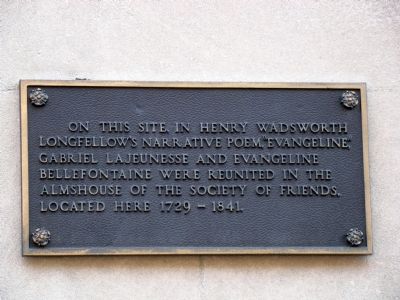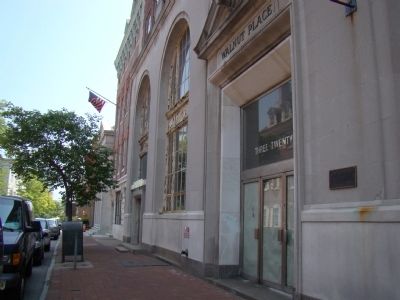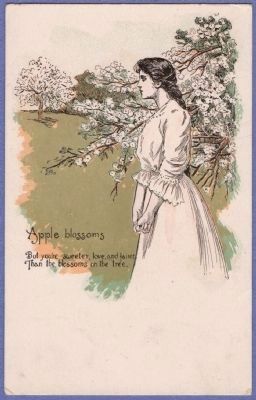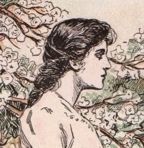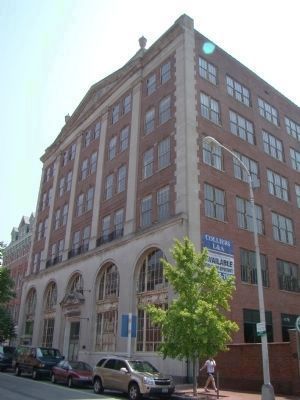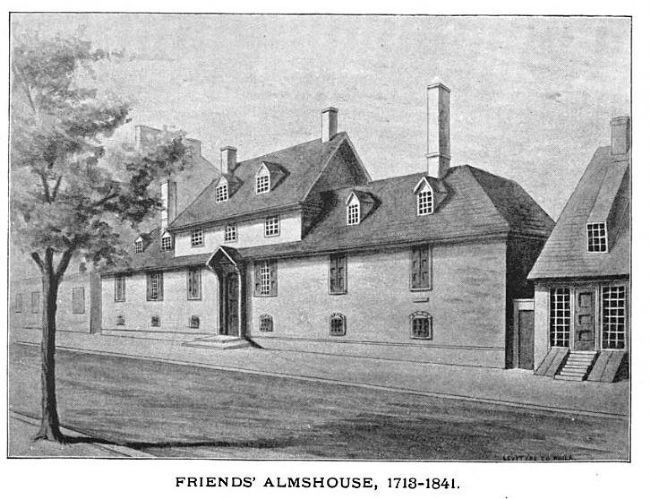Society Hill in Philadelphia in Philadelphia County, Pennsylvania — The American Northeast (Mid-Atlantic)
“Evangeline”
The Almshouse of the Society of Friends
Topics and series. This historical marker is listed in these topic lists: Arts, Letters, Music • Charity & Public Work. In addition, it is included in the Quakerism series list. A significant historical year for this entry is 1841.
Location. 39° 56.829′ N, 75° 8.823′ W. Marker is in Philadelphia, Pennsylvania, in Philadelphia County. It is in Society Hill. Marker is on Walnut Street west of South 3rd Street. It is on the wall to the right of the main entrance to the building. Touch for map. Marker is at or near this postal address: 320 Walnut St, Philadelphia PA 19106, United States of America. Touch for directions.
Other nearby markers. At least 8 other markers are within walking distance of this marker. Row Houses in the Capital City (within shouting distance of this marker); Dr. Benjamin Rush House Site (within shouting distance of this marker); 18th Century Garden (within shouting distance of this marker); Judge William Lewis (within shouting distance of this marker); Fort Wilson (within shouting distance of this marker); Old St. Joseph's Roman Catholic Church (within shouting distance of this marker); A Backyard in the Capital City (within shouting distance of this marker); Saint Joseph's Roman Catholic Church (within shouting distance of this marker). Touch for a list and map of all markers in Philadelphia.
Also see . . .
1. Evangeline, A Tale of Acadie. Wikipedia entry for Henry Wadsworth Longfellow’s poem. “The poem follows an Acadian girl named Evangeline and her search for her lost love Gabriel, set during the time of the Expulsion of the Acadians, the forced removal by the British between 1755 and 1763 of the Acadian people from present day Canadian Maritime provinces: Nova Scotia, New Brunswick, and Prince Edward Island (an area also known as Acadie).
The idea for the poem came from Longfellow's friend, Nathaniel Hawthorne. Longfellow used dactylic hexameter reminiscent of Greek and Latin classics, though the choice was criticized. It was published in 1847 and became Longfellow's most famous work in his lifetime. It remains one of his most popular and enduring works. The poem had a powerful effect in defining both Acadian history and identity in the nineteenth and twentieth century.” (Submitted on December 21, 2011.)
2. Link to the complete 1847 poem Evangeline.
(Excerpt)
Gayly the old man sang to the vibrant sound of his fiddle,
Tous les Bourgeois de Chartres, and Le Carillon de Dunkerque,
And anon with his wooden shoes beat time to the music.
Merrily, merrily whirled the wheels of the dizzying dances
Under the orchard-trees and down the path to the meadows;
Old folk and young together, and children mingled among them.
Fairest of all the maids was Evangeline, Benedict’s daughter!
Noblest of all the youths was Gabriel, son of the blacksmith!
. . .
(Excerpt)
Half-way down to the shore Evangeline waited in silence,
Not overcome with grief, but strong in the hour of affliction —
Calmly and sadly waited, until the procession approached her,
And she beheld the face of Gabriel pale with emotion.
Tears then filled her eyes, and, eagerly running to meet him,
Clasped she his hands, and laid her head on his shoulder and whispered —
“Gabriel! be of good cheer! for if we love one another,
Nothing, in truth, can harm us, whatever mischances may happen!”
. . .
(Excerpt, Philadelphia almshouse scene)
Thus, on a Sabbath morn, through the streets, deserted and silent,
Wending her quiet way, she entered the door of the almshouse.
Sweet on the summer air was the odor of flowers in the garden;
And she paused on her way to gather the fairest among them,
That the dying once more might rejoice in their fragrance and beauty.
Then, as she mounted the stairs to the corridors, cooled by the east wind,
Distant and soft on her ear fell the chimes from the belfry of Christ Church,
While, intermingled with these, across the meadows were wafted
Sounds of psalms, that were sung by the Swedes in their church at Wicaco.
Soft as descending wings fell the calm of the hour on her spirit;
Something within her said — “At length thy trials are ended;”
And, with a light in her looks, she entered the chambers of sickness.
. . .
(Excerpt, Philadelphia almshouse scene)
Suddenly, as if arrested by fear or a feeling of wonder,
Still she stood with her colorless lips apart, while a shudder
Ran through her frame, and, forgotten, the flowerets dropped from her fingers,
And from her eyes and cheeks the light and bloom of the morning.
Then there escaped from her lips a cry of such terrible anguish,
That the dying heard it, and started up from their pillows.
On the pallet before her was stretched the form of an old man.
Long, and thin, and gray were the locks that shaded his temples;
But, as he lay in the morning light, his face for a moment
Seemed to assume once more the forms of its earlier manhood;
So are wont to be changed the faces of those who are dying.
Hot and red on his lips still burned the flush of the fever,
As if life, like the Hebrew, with blood had besprinkled its portals,
That the Angel of Death might see the sign, and pass over,
Motionless, senseless, dying, he lay, and his spirit exhausted
Seemed to be sinking down to infinite depths in the darkness,
Darkness of slumber and death, forever sinking and sinking.
Then through those realms of shade, in multiplied reverberations,
Heard he that cry of pain, and through the hush that succeeded
Whispered a gentle voice, in accents tender and saint-like,
“Gabriel! O my beloved!” and died away into silence.
Then he beheld, in a dream, once more the home of his childhood;
Green Acadian meadows, with sylvan rivers among them,
Village, and mountain, and woodlands; and, walking under their shadow,
As in the days of her youth, Evangeline rose in his vision.
Tears came into his eyes; and as slowly he lifted his eyelids,
Vanished the vision away, but Evangeline knelt by his bedside.
Vainly he strove to whisper her name, for the accents unuttered
Died on his lips, and their motion revealed what his tongue would have spoken.
Vainly he strove to rise; and Evangeline, kneeling beside him,
Kissed his dying lips, and laid his head on her bosom
Sweet was the light of his eyes; but it suddenly sank into darkness,
As when a lamp is blown out by a gust of wind at a casement.
All was ended now, the hope, and the fear, and the sorrow,
All the aching of heart, the restless, unsatisfied longing,
All the dull, deep pain, and constant anguish of patience!
And, as she pressed once more the lifeless head to her bosom,
Meekly she bowed her own, and murmured, “Father, I thank thee!”
. . .
(Submitted on December 21, 2011.)
Additional commentary.
1. About the Friends’ Almshouse
Excerpt from the the 1890 book History and Reminiscences of the Philadelphia Almshouse and Philadelphia Hospital, Volume 1, by D. Hayes Agnew, M.D., et al.
The Friends' Almshouse of Philadelphia, which ante-dated by a number of years the first institution of the kind under the municipality, is described by Scharf and Westcott.
“. . .In the meantime, however, before the councils acted finally, the Friends had founded their own almshouse. It was established in a small house on the south side of Walnut street, between Third and Fourth streets, where, in 1729, the ancient, well-known building, called the Friends’ Almshouse, was built, to stand till 1841. The lot belonged to John Martin and contained a small tenement.. Martin was
poor, and gave his property to the society of friends upon condition that they would take care of him for the remainder of his days. A cluster of small houses was built to John Martin’s tenement, and this was the Friends’ Almshouse. In 1729 a front range of buildings was put up connecting with the previous structures. It was a quaint pile with an arched entrance, and all about the buildings looked antique and primitive. The Friends’ Almshouse, at first in general public use, soon became a private retreat for indigent persons of the Quaker faith. Each family was separately lodged, and if any had a trade or calling, he was expected to do what he could at it and so lessen the burthen of his expense to the society.”
— Submitted December 21, 2011, by J. J. Prats of Powell, Ohio.
2. Maybe It Wasn’t This Almshouse
Excerpt from the the 1890 book History and Reminiscences of the Philadelphia Almshouse and Philadelphia Hospital, Volume 1, by D. Hayes Agnew, M.D., et al.
“The old Philadelphia Almshouse and its hospital wards have not escaped the gentle attentions of the poet. The readers of Longfellow will remember the pathetic ending of the story of Evangeline; how in the wards of the old almshouse hospital in the time of one of the terrible plagues, so eloquently referred to by Dr. Agnew, after years of troublous wandering, the two lovers, now grown old in years and suffering, again met for a few brief hours before death parted them forever. Evangeline, who had become a sister of mercy, recognizes her old lover Gabriel in one of
the fever stricken patients. As it was in 1755, that the French Acadians of Grand Pré, nineteen hundred peaceful, happy souls were dispossessed of their homes, and began their wanderings, the event idealized by the poet can probably be referred to the epidemic of yellow fever in 1793, and to the almshouse building at Tenth and Spruce streets, first occupied in 1767. This incident has been described as occurring in the old Fourth and Spruce streets almshouse, occupied from 1732 to 1767; but as Gabriel and Evangeline had grown old and gray, the meeting evidently should be located in the institution on the Society Grounds between Tenth and Eleventh streets.”
— Submitted December 21, 2011, by J. J. Prats of Powell, Ohio.
Credits. This page was last revised on February 2, 2023. It was originally submitted on December 21, 2011, by J. J. Prats of Powell, Ohio. This page has been viewed 1,630 times since then and 72 times this year. It was the Marker of the Week January 8, 2012. Photos: 1, 2, 3. submitted on December 21, 2011, by J. J. Prats of Powell, Ohio. 4. submitted on January 10, 2012, by J. J. Prats of Powell, Ohio. 5, 6. submitted on December 21, 2011, by J. J. Prats of Powell, Ohio.
